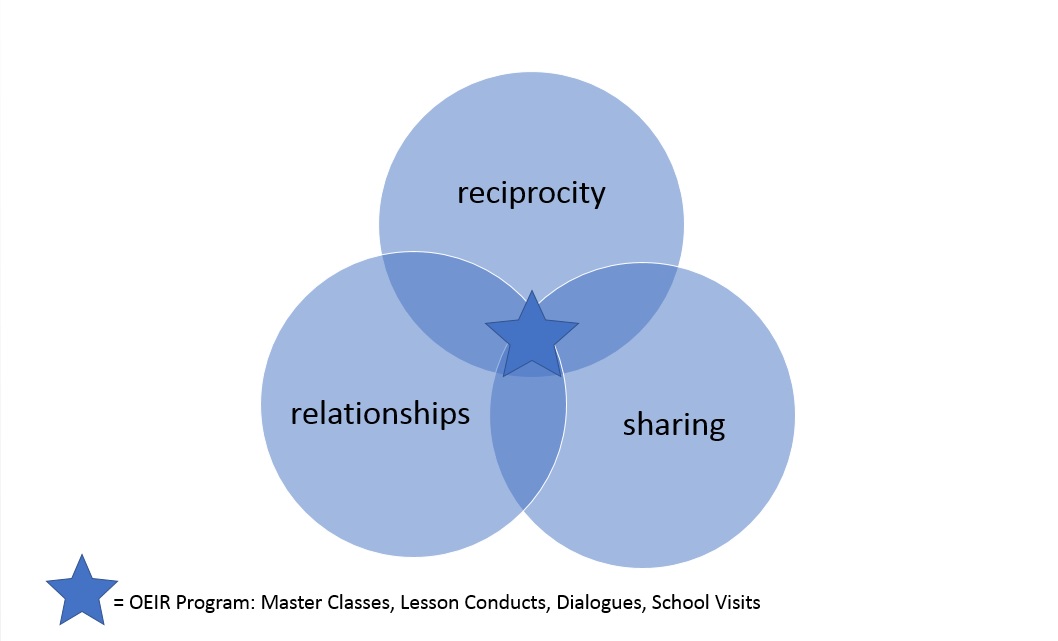Geography educator Susan Caldis has just returned from a two-week professional learning opportunity in Singapore, where she took part in the 2019 Outstanding Educator In Residence (OEIR) program. The program, hosted by The Academy of Singapore Teachers, establishes partnerships with professionals around the world to tap into their expertise to enhance the professional development of Singaporean teachers. In today's Q&A she discusses the highlights from her experience and some of the work she did while abroad.
Could you share some highlights from your professional learning experience in Singapore?
Every day was a highlight as it brought a new experience, challenged my thinking, and confirmed my interest in wanting to explore the enactment and profile of geography education outside of Australia. Every day I was grateful to be immersed in the Singapore context because the enduring highlight was the opportunity to be able to meaningfully engage with local students, local teachers and local leaders of geographical education.
I could talk about particular parts of the OEIR program as being highlights, such as a Year 9 Geography lesson conducted in a local neighbourhood school, the stretching of my intercultural understanding, and of course the array of delicious food that was eaten. However, it was during the final week of the OEIR program that I realised the real highlight – I had learnt a lot.
I had learnt about Singapore as a nation and its education system. I had learnt about facts and figures, and communities and places. However, in addition to such ‘tangible' learnings, there was also the intangible learning: values, attitudes, aspirations, the meaning of the word ‘educator'.
The only way I can start to explain this highlight is from the words of my OEIR Reflection Report submitted to the Academy of Singaporean Teachers on the last day of the program. Such words also became the visual representation and opening statement of my verbal presentation to Directors and colleagues of the Academy:
On the agenda for the OEIR Program, these words seemed important and they were written at frequent intervals: masterclasses, dialogues and school visits. These words also seemed significant and they also appeared regularly throughout the program: lunch, cultural program, lesson conduct. However, three words became the most important and significant, but they were never written, they were always enacted: relationships, reciprocity and sharing.

Could you run through some of the activities that you participated in?
Whilst in Singapore I participated in a whole array of activities and programs. I designed and delivered a series of masterclasses for in-service Geography teachers, ran a Year 9 Geography lesson, participated in four dialogues, as well as an observation of Geography lessons and a cultural program.
The lesson was focused on housing, which is part of the Urban Living topic. Class sizes are larger in Singapore compared to Australia. Typically, each lower secondary class (Years 7-9) would have up to 40 students and the class I taught was no exception.
Essentially, within the 50 minute lesson, students and I co-constructed an inquiry question and hypothesis and then together we decided how to best find a response to this co-constructed question through primary research. Then the students worked in groups outside the classroom and around the school grounds to conduct a short fieldwork activity such as observation notes, tallies, and annotated photographs.
Upon returning to the classroom, students worked in their groups and shared their primary research findings on a lotus chart and then, as a class, we completed a brief analysis of findings to determine whether or not we had a suitable response to the co-constructed question. At the end of the lesson, a feedback exit slip activity was conducted with students who participated in the lesson and teachers who observed me teach.
A selection of comments are included below:
- ‘Miss Susan is entertaining and gave us an activity that is fun but we still gathered good knowledge about Geography.' (Student 1)
- ‘I liked it when we tallied up things and when we were given a lotus chart to summarise what we found. It was interesting and enjoyable.' (Student 2)
- ‘I like the fieldwork as I can learn Geography outside the classroom.' (Student 3)
- ‘Really love the way the lotus chart is used in the classroom. Very structured and focused. Students can get fieldwork analysis done within the short classroom time.' (Teacher 1)
I also participated in four dialogues. These were typically a two hour ‘round-table' discussion with different key stakeholders in geographical education. The first dialogue was with the Subject Chapter of Geography Teachers. The Subject Chapter is led by the Master Teachers of Geography at the Academy of Singaporean Teachers and members include the Senior and Lead Teachers of Geography based in schools across Singapore. The Master Teachers chose one of my publications (Geography Comes Alive Through Fieldwork, 2015) as a discussion starter for Chapter members and as a point of reflection upon their classroom practice.
One of the dialogues enabled me to engage with the Curriculum and Professional Development Division of the Ministry of Education. Questions were focused around curriculum development and implementation, resource development, signature pedagogies of Geography, and of course exploration of the similarities and differences between the Singaporean and Australian teaching contexts.
Another dialogue was held at the National Institute of Education where discussion focused on the design and implementation of the Geography Methodology program for pre-service teachers, with much focus on the importance of pedagogical content knowledge as an underpinning frame for each unit within the program, and ensuring preservice teachers have adequate time to experience, plan for, and design fieldwork-related activities.
The final dialogue was more ‘masterclass' in nature, duration and style. This dialogue was with the Heads of Department who may not necessarily be Geography teachers themselves but are responsible for leading Geography as one of the subjects within a Humanities and Social Sciences Department at school.
Another activity I was really fortunate to participate in was the observation of Geography lessons followed by professional dialogue and reflection with the teacher and their Head of Department, using the ‘I noticed and I wonder' protocol. The lessons were all taught by specialist Geography teachers who ranged from early career through to Lead Teacher and Head of Department stages.
There was also a cultural program to support my learning about Singapore: its people, place, history, cultural ways of being, connections with neighbouring nations, and need to be future-facing. The cultural program occurred via a formal itinerary on a weekend, and informally during the week through activities such as being given books to read and review/reflect on, and more structured conversations with colleagues from the Academy of Singaporean Teachers which focused on questions and observations I had about my cultural learning throughout each week.
You presented a series of masterclasses for in-service teachers. What topic did you present on? Were your masterclasses well received by participants?
The masterclasses were of a three hour duration, held in schools or at the Academy of Singaporean Teachers. Apparently, there are 600 registered Geography teachers in Singapore and the masterclasses were at capacity attendance so we were able to reach about 30 per cent of Geography teachers face-to-face.
The masterclasses were formally framed as Big Ideas, Key Questions and Lotus Charts: Designing student-centric geographical inquiry and fieldwork. The intent of the masterclass was to share strategies for planning and implementing a Geography lesson that could incorporate the co-construction of an inquiry question with students.
Teachers were encouraged to use the lotus chart as a planning tool to reason and reflect on their ideas about planning a lesson for bite-sized fieldwork to occur. Sharing of responses also occurred. A learning moment for me was to realise that specific prompts and directions towards tables and/or individuals was required to elicit the sharing of examples.
In Australia, facilitators of professional learning often ‘throw-it-out' to the crowd and then manage the plethora of raised hands and diversity of responses being ‘thrown back'. In Singapore I had to manage the silence. Initially this was managed through providing my own example to the audience in response to my own question and then moving on to the next activity.
Upon further discussion with the OEIR team and closer observations about such a scenario in the school visits, I realised it is acceptable and expected for the facilitator to nominate people and groups to speak for the purpose of sharing. I saw this happen in the classroom between teacher and student. This was an uncomfortable strategy for me to buy-in to and adopt.
Hesitantly, I tried this strategy in the second masterclass, although I had spoken to the group prior to nominating them to give them the ‘heads-up' that their responses would be confirming and interesting for other colleagues at the masterclass to hear. It worked, the nominated group shared their response.
In the third masterclass my confidence had grown and I was able to nominate individuals and groups to speak, although I did veer towards Subject Chapter members and Geography teachers from schools that I had met during the week. Again, the nominating was successful.
By the final masterclass, nominating groups and individuals to speak was much less stilted and uncomfortable for me to enact. To discover the masterclasses had helped teachers to ‘feel less daunted by inquiry and fieldwork' was encouraging. The intention is for colleagues from the Academy and I to follow-up with masterclass participants within three to six months, potentially through a Skype session, so that participants can share their experiences of implementing strategies learnt from the masterclass.
Stay tuned: In an upcoming Q&A, Susan Caldis will share how she tracked the success of her experiences in Singapore and how she plans to share what she learned with the Geography community in Australia.
Susan Caldis shares a learning moment where she had to adapt her approach to group discussions. She says: ‘This was an uncomfortable strategy for me to buy-in to and adopt’.
How often do you step out of your comfort zone to try something new in your classroom? Is this something you could commit to doing more often?
When facilitating group discussions in your classroom, do you nominate students to speak or do you ask them to self-nominate? What have you found to be the most effective approach in your classroom?



